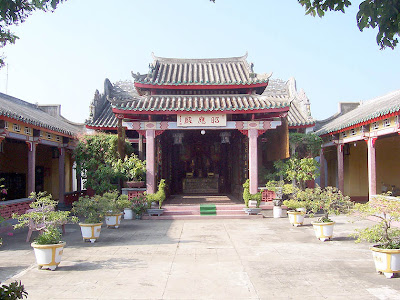Our bus trip was straightforward through Da Nang with only a brief stop to let off those stopping there, but when the driver and tout reached Hoi An, they blatantly stopped before we got into town to allow a hotel proprietor who had obviously paid them scam money managed to persuade about half the passengers to go to his hotel. They then drove right through Hoi An out to the other side to another out of the way hotel, managing to convince 2/3rds of the passengers to get off in hotels on the periphery. Only after I staged a threatening protest calling the whole act a scam did they drive us back into town and let us off in the hotel district, despite repeatedly complaining that they couldn't stop in town because there was no parking.
Hoi An has a large number of hotels in the loop between Ba Trieu and Nhi Trung and there is no problem about the bus stopping there, but the central hotels won't pay the bus scam money because they are already well-situated. We heard of worse instances where buses refused to let passengers off at major destinations like Hue, forcing them on to Hoi An claiming they didn't have time to get their luggage off the roof.
Immediately we found a hotel - the Hoa Binh, #15 Nhi Trung St.(#696 Hai Ba Trung), for $7 a night with $2 extra for air con (the 2008 prices quoted on the internet as I write were only a little higher at $12-$15). As of 2010 there are still only a few reviews of this hotel.
We haven't had air-con during the trip until Hanoi but it`s particularly hot and humid in Vietnam and the extra isn't much for the escape it provides.
We were happy there but the one thing we were a bit concerned about was that they arranged a package for the train to Saigon. They have also arranged to book our train from Da Nang to Saigon for about $6 more than the travel agents, but it includes transport back to Da Nang so it seems like an okay deal. However other travel agents have chided us that they would have provided tickets up front the next day so we will have to wait and see if we have to storm back to Hoi An to complain.
As things turned out, we took the taxi to the station in Da Nang which the hotel promised was included in the price they had arranged to book for us, but when we drove there, the taxi driver, who was a decent guy, seemed to be unsure he was going to get paid and kept asking us how he was going to get the money, so we gave him a signed note to take back to the hotel saying they had promised to pay him. (Another devious scam?)
Christine has found a cheap restaurant among the many slightly overpriced water-front bars and cafes. It`s called Huu Nghi (Friendship). It serves a very nice chicken and mixed vegetables with rice for 25,000 dong which is what the Lonely Planet says you should be able to eat for, despite all the other restaurants charging something from 40,000 to 80,000 for something pretty similar. It's right down the end of the waterfront, just before the markets begin. For some reason there were only a few customers, but we went there faithfully for dinner the last two nights. Next door the Riverside, which scurrilously claims it used to be no 4 on the Lonely Planet as the Rendezvous - (which also seems to be a scam as there is no such thing in our book) serves cheap vegetable omelettes and very good chocolate banana pancakes for 10,000 dong, so we have been going to one for breakfast and the other for dinner.



Today on our second day we hired a brand new motor bike for only $3 US and used it to ride out to the sweeping white sand beach that stretches all the way back to Da Nang. The fruit sellers were also offering 'happy hour' in little envelopes which they promised they wouldn't tell on us for taking, but how can you be sure? Isn't it a cut both ways for them? I wish I knew what it was in retrospect, but I've already done the drug circuit long ago in the 1970s and we aren't trying to run the gauntlet of the Vietnamese fuzz.
After that we made a multi-stop tour of the old houses and temples, after which I rode out to some of the neighbourhoods on the neighbouring islands and peninsulas all of which are in the photo blog below.
But Hoi An is VERY hot and humid and its quite a long way from the hotel street Nhi Trun to the waterfront where the restaurants are, so we won't be sorry to be on the night train for Saigon.













 Fishing in the harbour
Fishing in the harbour

































Here are a few images from a part of Hoi An on the road in from Hue

 A slightly derelict Cao Dai Church with the 'third eye'
A slightly derelict Cao Dai Church with the 'third eye'













































No comments:
Post a Comment